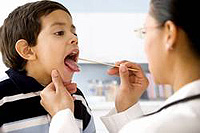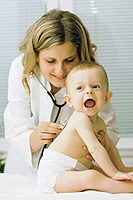What is diphtheria? What are the causes of diphtheria? How is the process of disease development? Answers to these questions you will find in the article.
Content
What is diphtheria, causes and the process of disease development
Diphtheria - acute infectious disease characterized by a local inflammatory process, mainly mucous membranes, phenomena of general intoxication and toxic damage to cardiovascular and nervous systems.
The causative agent of diphtheria is bacterium, resistant to high and low temperatures. It can remain for a long time on the subjects that the patient enjoyed. Quickly dies when boiling and exposed to disinfectants. In the process of breeding in tissues, the diphtheria chopstick produces toxin, which plays a major role in the development of the disease.
The source of infection is a sick person and «Healthy» Diffine stick carriers producing toxin. Patients are the greatest danger. At the same time, at least 90% of diphtheria diseases are associated with infection from «Healthy» Media carriers diphtheria. The pathogen is localized in the nasopharynx and the upper respiratory tract, standing out into the external environment with droplets of the nasopharynxal mucus. Aircraft transmission path has crucial importance in distribution of infection. Difteria microbes with droplets of saliva and nasopharynxal mucus are released into the air with patients and carriers when talking, sneezing, cough.
The pathogen is most often introduced into the mucous membranes of the oz, less often there is another localization of entrance gates (leather, eye, ear, wound, etc.). A local inflammatory process develops at the site of introduction into the body of the diphtheria stick. The toxin of the pathogen applies to the surrounding tissues and causes swelling, full-blood, hemorrhage, fabric death and fibrinous film. In addition, toxin, who was suiced from the place of reproduction of the pathogen, enters the blood and applies to the body, causing the phenomena of general intoxication and the defeat of cardiovascular and nervous systems. After the suffered infection remains persistent immunity.
Symptoms of diphtheria
 The incubation period is 2-10 days. Depending on the localization of the primary process, diphtheria of the oz, larynx, nose and rare forms (eyes, ear, skin, wounds, genital organs) are distinguished. Most often occurs difteria, In which for the prevalence of raids, form shapes are distinguished: localized (island, film) and widespread. Diphthery ZEVA is characterized by fever, intoxication and local inflammatory changes in the sky almonds.
The incubation period is 2-10 days. Depending on the localization of the primary process, diphtheria of the oz, larynx, nose and rare forms (eyes, ear, skin, wounds, genital organs) are distinguished. Most often occurs difteria, In which for the prevalence of raids, form shapes are distinguished: localized (island, film) and widespread. Diphthery ZEVA is characterized by fever, intoxication and local inflammatory changes in the sky almonds.
The disease begins with weakness, malaise, disorders of appetite. A feature of fever during diphtheria is its short-term and not pronounced. Body temperature, often the entire period of the disease, may not exceed 38c, and sometimes normal or increase to 38c in the first 2-4 days, then coming to normal. The toxic forms of diphtheria may be accompanied by a high temperature for 4-5 days, but then local and general changes are developing against the background of normal body temperature.
Inxication during diphtheria, in contrast to other infectious diseases, is manifested by lethargy, drowsiness, adamisia, skin pallor and is not accompanied by severe chills, strong headache, fragile in the body.
Simultaneously with generaloxic syndrome, local changes arise. A feature of this inflammatory process in diphtheria of the oz is non-market hyperemia with a blue tint, pronounced swelling, the presence of plaque on the surface of affected almonds with a minor severity of pain in the throat during swallowing and angular lymph nodes when they are tight.
Complications, warning and emergency care for diphtheria
Complications of diphtheria are due to the action on the body of diphtheria toxin - myocarditis, paralysis of the muscles of the heart, palsy of the respiratory muscles and the diaphragms, neuritis.
For laboratory confirmation of the diagnosis, a study of a smear of a zea and nose is carried out.
Sick diphtheria, as well as patients with suspected diphtheria are subject to immediate insulation and evacuation into the hospital infectious department, where anti-infectious serum is introduced and further treatment is carried out.
The main event on diphtheria prevention is properly organized and timely vaccinated with diphtheria. To this end, every 10 years should be revaccination against diphtheria.
Disinfection is held in the apartment.
Behind persons in contact with the patient or carrier of the diphtheria sticks are established medical observation for 7 days and bacteriological research on carriage.









